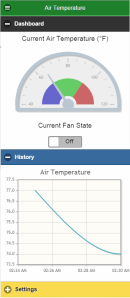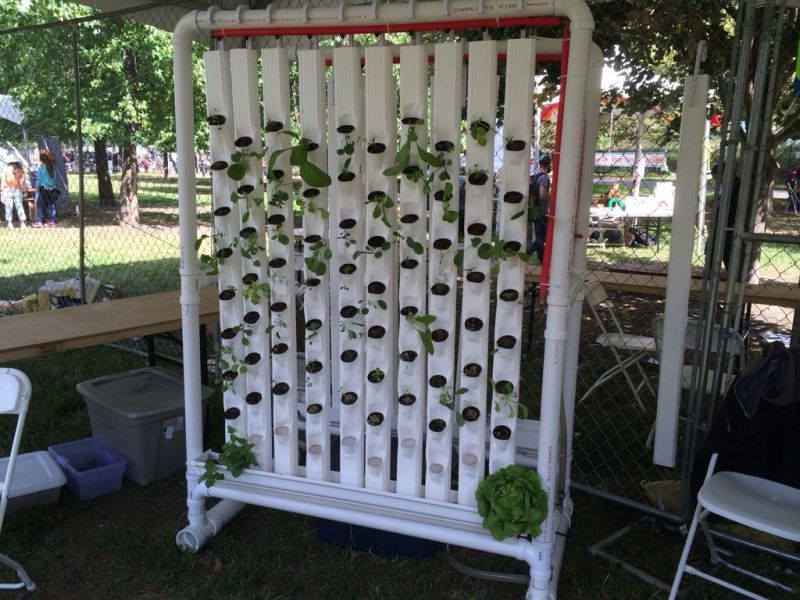Now there is no excuse to not have a garden, even if you are located in an urban area. The Robotic Urban Farm System (RUFS for short) solves the problems of growing many plants in a small area. The system’s high plant density is attributed to its vertical orientation. The entire system is even made from easy to find parts from your local hardware store. The water usage is kept to a minimum thanks to the closed loop watering system. Instead of flowing down into the ground, any excess water is collected and saved for use later.
Plants are placed in holes made in the side of a standard plastic downspout that hangs from a PVC frame, each hole several inches apart from its neighbor. A standard plastic plant pot is place inside each hole and is filled with hydroponic media. That’s right, there is no dirt in this system. Plants will grow happily in the hydroponic media providing they get all the nutrients and water they need.
 The potential urban farmer may not be super excited about tending to his crops. This is where the robot portion of the RUFS system comes into play. There are two control systems that work independently of each other. The first is for indoor applications and controls light cycles and circulation fans. The second is a little more complex and controls the watering portion of the system. Not only does it water the plants at pre-determined intervals but it also monitors the pH, nutrient and water levels inside the reservoir. Both these systems are Arduino-based. For extreme control freaks, there is one more add-on available. It’s Raspberry Pi based and has an accompanying mobile app. The Pi records and logs sensor data from the Arduinos and also allows remote updating of the watering and light schedules. The mobile app lets you not only look at current conditions of the system but also displays the historical data in a nice visual graph.
The potential urban farmer may not be super excited about tending to his crops. This is where the robot portion of the RUFS system comes into play. There are two control systems that work independently of each other. The first is for indoor applications and controls light cycles and circulation fans. The second is a little more complex and controls the watering portion of the system. Not only does it water the plants at pre-determined intervals but it also monitors the pH, nutrient and water levels inside the reservoir. Both these systems are Arduino-based. For extreme control freaks, there is one more add-on available. It’s Raspberry Pi based and has an accompanying mobile app. The Pi records and logs sensor data from the Arduinos and also allows remote updating of the watering and light schedules. The mobile app lets you not only look at current conditions of the system but also displays the historical data in a nice visual graph.
















I do believe this water would be gettin real FUNKY!
What is funky to us might be yummy to plants! And by “closed system” I don’t think they mean the water is undrainable.
http://www.elearnenglishlanguage.com/blog/english-mistakes/its/
http://en.wiktionary.org/wiki/world%27s_smallest_violin
On a site focused on education and learning it’d be nice if they took the time to proof-read their posts even once. Grammar, punctuation and using correct spellings aren’t ‘meh’ topics worthy of ‘smallest violin’. ie: independant vs independent.
I would be really interested in this but my wife would throw down the FoodSafe plastic card. Can you get the PVC in Food Safe or BPA-free plastic?
I doubt it since PVC made for outdoor use (downspout pipe) usually has UV protectant and other stuff added to protect it from the elements. Personally, I wouldn’t worry about it, but you COULD use metal downspout pipe instead.
Cool project. It has me thinking …
Seems the acid buildup in the fertilizer might be worse for metal. If i remember right this idea translates to food storage.
Not sure if you want to consider further damage to the metal from other means, I imagine drain pipe itself is coated somehow to prevent rust, which might last a while but could be effected by the fertilizers as well.
Copper or aluminium pipe would be workable though, wouldn’t it?
Does ABS have BPA in it? Could use that. Then you could 3D print it. It already has a RaspberryPi and an Arduino in it. Might as well go for the hat trick
They make HDPE and ABS pipe, both of which are now being used for waterlines and also PEX. I don’t know about long term safety on any of those but they could be an alternative possibility.
Also is it just me or does this particular article sound less like HaD’s normal editorial tone and more like an ad?
Pex is more or less recognized to be safe by now. It’s been in use in household plumbing systems for quite some time, and is generally accepted by building codes.
Though the building codes and standardization were likely for a somewhat ph neutral water. From what I have read it seems that as the fertilizer runs through, plastics in containers and waterways will change/absorb in ph and leach back into the soil.
I think the best answer will be some type of plastic and cleaning regimine, it will be interesting to know which and by how much. Metal I would bemore worried about chemical reactions and by-products that I can even begin to understand (protective coatings being stripped off, rust, etc).
The instructions say they use PEX for the water supply lines. The PVC was used for the structural aspect of the system and you could switch it out for any water resistant material.
Though as it is a closed loop the nutrients will drain through the pvc/structure before being recycled and feed through again.
I love this and you can simplify this down to install in any sized garden!
Isn’t this just yet another aeroponics setup? Don’t get me wrong, it’s a nice compact design, but this stuff has been around for ages hasn’t it?
I was thinking the same, and I am not sure what the link is to robotic gardening. I was expecting to see robots, a mechanical arm, maybe a fully automated planting/cropping system.
The home hydro hobby as been around for a while- there are even kits in grocery stores. Dont get me wrong, I like to see innovation but nothing new here. I think the Romans did it well and did not have to use a PI. Maybe I would have recieved this better if it was titled less spectacular, “Furthering DIY Hydroponics” or the like.
Looks like it uses sensors and injectors to maintain pH and plant food. Sounds like automation to me. Are these not the droids your looking for? :p
Looks like it’s fully automated to run lights, pump, ph and all the plant food.
Guess the Romans had slaves for that. These are not the droids your looking for.
While they almost undoubtedly used slaves to build these auquaducts, they used gravity through proper planning and engineering.
Looks like it maintains pH and plant nutrients via sensors and injectors. And a phone app. Haven’t seen that in my grocery store yet. Did you read the page in the link or just look at the picture?
Aluminum Downspout is readily available. Plants actually don’t pick up much stray organics if they have the correct amount of nutrients available. But they will pick up metals. ABS and PVC don’t generally have BPA, the largest single source is thermal cash register paper at 20,000 x exposure for 1 tape in your mouth.(tell me you never put a Walmart tape cash tape in your mouth) Lead is no longer used in North American Housing Materials.
For fertilizer resitstance, the best stuff is stainless steel and polypropylene. That’s what we use for pumping unduluted fertilizer. Call up a hose and pipe supply place to find experts who know chemical resistance, sizes and shapes of fittings, and prices.